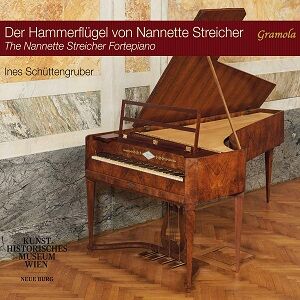
The Nannette Streicher Fortepiano
Ludwig van Beethoven (1770-1827)
Fantasie in G minor, Op. 77 (1809)
Johann Nepomuk Hummel (1778-1837)
La Sentinelle, Op. 34 (1810)
Franz Schubert (1797-1828)
Fantasie in C minor, D. 2E (1811)
Ignaz Moscheles (1794-1870)
Fantasie héroique, Op. 13 (1812)
Jan Václav Hugo Voříšek (1791-1825)
Fantasie für Klavier, Op. 12 (1822)
Anna Maria (Nannette) Streicher (1769-1833)
Deux Marches pour le piano-forte (1817)
Ines Schüttengruber (fortepiano)
rec. 2022, Marble Hall in Neue Burg, Vienna
Gramola 99273 [61]
This recording features a Hammerflügel (fortepiano) built in 1813 by Anna Maria (Nannette) Streicher (née Anna-Maria Stein; 1769–1833), which is stored in Vienna’s Kunsthistorisches Museum. She moved to Vienna in 1794 with her husband Johann Andreas Streicher and established a piano manufacturing business that became as successful as those of Johann Schantz and Anton Walter. Franz Joseph Haydn and Ludwig van Beethoven were among the composers in her social circle. She was on particularly close terms with Beethoven, who praised the quality of her fortepianos.
Virtues of this disc extend beyond the historic keyboard that Ines Schüttengruber plays: the works selected include the infrequently performed Fantasie in G minor (1809) by Beethoven, which gives insight into the composer’s improvisatory spirit. His 32 ‘canonical’ piano sonatas have been recorded multiple times and are, thus, the most accessible aural representation of his output for solo piano. Before deafness forced him to retire from performing in front of audiences, he was famous for improvising at the keyboard, either with or without a specific theme. The Fantasie is an instance in which he committed some of his extemporaneous ideas to paper.
Johann Nepomuk Hummel is best known today for his Trumpet Concerto in E Major (1803), but this former student of Wolfgang Amadeus Mozart and Antonio Salieri was famous as a pianist (performer and teacher). La Sentinelle from his Trois thèmes variés, Op. 34 (1810) gives performers a chance to use the piano’s soft pedal. Judging by the compositional quality in evidence here, I wish that the other two themes that comprise Hummel’s Op. 34 had been included.
Written at the age of fourteen, Franz Schubert’s Fantasie in C minor (1811) reveals his engagement with Mozart’s Fantasie in the same key, K. 475. This six-minute work resembles Mozart in the opening bars, but develops a Schubertian voice that anticipates the searching, melancholic atmosphere of the Fantasie in F minor, D. 940 (1828) for piano duet.
Ignaz Moscheles was a student of Salieri and acquainted with Beethoven and Streicher. His Fantasie héroique (1812) provides valuable context for Beethoven and Schubert. The same can be said for Jan Václav Hugo Voříšek, whose Fantasie for piano (1822) shows some of the diversity in pianistic composition in Vienna during the early nineteenth century. The recording catalogue has created an unbalanced view with its proliferation of works by Beethoven, Schubert, and Franz Liszt. Voříšek represented a rhapsodic form of writing that was playable by competent pianists of the day (e.g., in salons) and, thus, a contrast to Beethoven’s Sonata in B-flat, Op. 106 ‘Hammerklavier’, which was deemed unplayable during the composer’s lifetime.
The two marches by Nannette Streicher played on her own instrument demonstrate that her talents extended beyond designing pianos. Further short works of hers would add even more value to this important document that will please lovers of historic pianos and of the ‘Viennese Classic’ period. The disc comes with a booklet featuring essays in German and English about the instrument, Streicher as a piano builder at the vanguard of the rapidly developing technologies of the time, and the compositions themselves. Schüttengruber’s agility and precision demonstrate the instrument’s possibilities. Her commitment to late-eighteenth and early-nineteenth-century repertoire awakens hope that more recordings by this artist will appear in due course.
Daniel Floyd
Help us financially by purchasing from





















